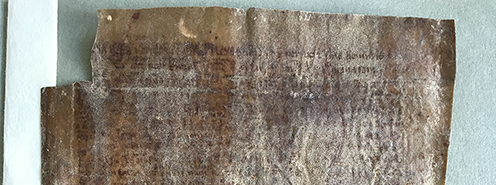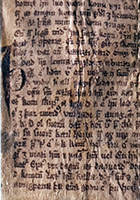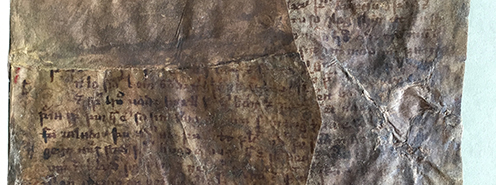16 May 2018
Sad remains of once proud books
Manuscript of the Month
AM 567 4to is a large collection of fragments with texts from medieval Icelandic romances, most comprising only one or two leaves.

AM 567 4to XIV ß, a fragment of Hrólfs saga Gautrekssonar from c. 1300. The recto side, shown here, is largely illegible, the leaf having been used as a cover for a smaller manuscript. On an accompanying leaf Árni Magnússon has written: “Þetta blad er ur Hrolfs søgu Gautrekssonar. Er gamallt.” (This leaf is from Hrólfs saga Gautrekssonar. It’s old.) (Click on the image for a larger version.)
Romance in fragments
Under the shelfmark AM 567 4to is found a large collection of fragments – most comprising only one or two leaves, a couple as many as six or eight. The fragments contain texts of “Fabulosæ Islandorum Historiæ”, i.e. late medieval Icelandic romances, nowadays generally known by their Icelandic name, riddarasögur (lit. ‘sagas of knights’). There are about 35 of these which have survived from the mediaeval period. Many were extremely popular, and are found in upwards of 70 manuscripts, and most were recast as rímur, that most Icelandic of genres. There are also a few items which would be classed as fornaldarsögur Norðurlanda (lit. ‘stories of ancient times in the northern lands’), as well as the odd ævintýri (‘adventure’), both also types of romance, and frequent sources for rímur treatment.
Most of the fragments in this collection are from the 14th and 15th centuries, the heyday, as it were, of the romances. Because of their age, a good many of them, although fragmentary, are extremely valuable as witnesses to the early histories of the texts they preserve and have been made use of in critical editions.

AM 567 4to XVII α, two bifolia preserving text fragments from Mágus saga jarls, 15th century. (Click on the image for a larger version.)
As far as is known, these fragments are all that remain of the codices to which they once belonged. How large and impressive these codices may have been we can only guess at. Many, although comprising only a few leaves, contain fragments of more than one saga, suggesting that they must have been of some size, and although most are now badly damaged, either through use or deliberate “repurposing” as book-covers, traces of coloured initials and so on suggest that a few of them at least must have been very impressive indeed. Altogether, there are fragments from 34 codices.
Bits of text from 29 sagas
The texts preserved in these fragments stem from 29 separate sagas, some represented by only a single fragment, others by several. Most of the sagas are well known, such as the delightful and highly popular Nitida saga, preserved in 66 manuscripts and recast at least eight times in rímur. Other items less so: one of the last fragments in the collection, unfortunately badly damaged, preserves text from a story called “Af þrimr þjófum in Danmörk“ (Of three thieves in Denmark), also known as “Af Ill, Verri og Verst” (Of Bad, Worse and Worst), from the highly appropriate names of the three chief protagonists. This too formed the basis for a set of rímur.
The collection is divided up into 26 subgroups, indicated by roman numerals, in part according to contents, in part according to the codices from which the fragments came. AM 567 4to II, for example, comprises six leaves from a single codex. On the first leaf there is text from Bevers saga, on leaves two and three from Remundar saga, two separate unconnected fragments, on leaves four and five two fragments, equally unconnected, from Elis saga, and finally, on leaf six, a fragment of Bærings saga (other pieces from these sagas are found in other fragments in the collection: Bevers saga in VII, Remundar saga in XIX and Elis saga in X). AM 567 4to XX, on the other hand, consists of two single vellum leaves from two otherwise lost codices; both contain sections of the text of Sigurðar saga þögla, one of the more popular of the late medieval romances. The fragment XX α is dated by Kristian Kålund to the 15th century, fragment XX ß to the beginning of the 16th. The earlier fragment is interesting for a number of reasons. The text is written in a single hand, with the exception of two lines on the recto and four on the verso, which are written in a second hand, presumably that of someone still in training. Although, as was mentioned, many of the fragments in the collection are badly damaged – the recto side of XX ß, for example, is now largely illegible, the leaf having been used as a cover for some other manuscript, the text on XX α is clear and easily legible.
As with the Arnamagnæan Manuscript Collection in general, the manuscript fragments gathered under the shelfmark AM 567 4to have been divided between Denmark and Iceland, with roughly half now in each place.
The fragility of the written word
Collections such as these – and there are several within the Arnamagnæan Collection – remind us of just how fragile manuscript transmission can be. Around 900 Icelandic vernacular manuscripts survive from the period before 1600. Most of these are fragmentary or defective: in fact, fully half consist of five leaves or fewer, and 15% of only a single leaf or a part thereof. Estimates vary, but even these 900 manuscripts are thought to represent no more than 15% of those actually produced in Iceland in the mediaeval period, and quite possibly only half that. Árni Magnússon was keenly aware of this fragility, and made every effort to get hold of every scrap of vellum he could to preserve it for posterity, carefully noting where the fragments came from, and what texts they contained. We can only be grateful for his diligence.

AM 567 4to XXV, the remains of a bifolium from the 15th century containing a fragment of the story “Af þrimr þjófum in Danmörk“ (Of three thieves in Denmark), also known as “Af Ill, Verri og Verst” (Of Bad, Worse and Worst). (Click the image for a larger version.)



